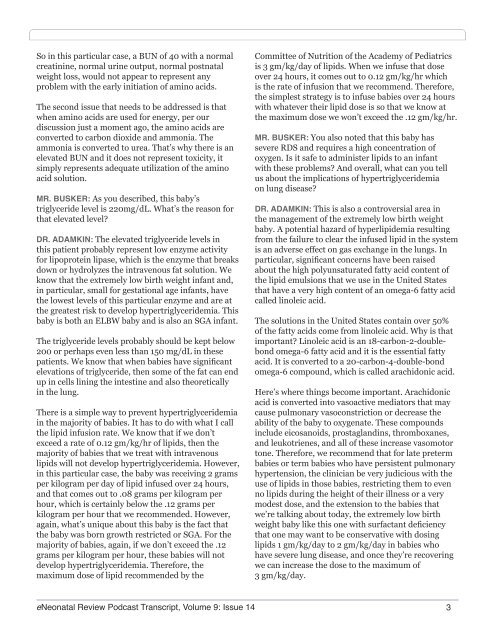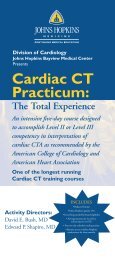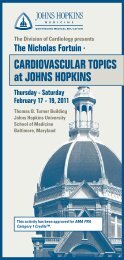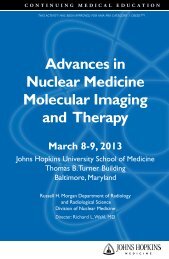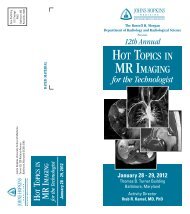View Transcript - Hopkins CME Blog
View Transcript - Hopkins CME Blog
View Transcript - Hopkins CME Blog
You also want an ePaper? Increase the reach of your titles
YUMPU automatically turns print PDFs into web optimized ePapers that Google loves.
So in this particular case, a BUN of 40 with a normal<br />
creatinine, normal urine output, normal postnatal<br />
weight loss, would not appear to represent any<br />
problem with the early initiation of amino acids.<br />
The second issue that needs to be addressed is that<br />
when amino acids are used for energy, per our<br />
discussion just a moment ago, the amino acids are<br />
converted to carbon dioxide and ammonia. The<br />
ammonia is converted to urea. That’s why there is an<br />
elevated BUN and it does not represent toxicity, it<br />
simply represents adequate utilization of the amino<br />
acid solution.<br />
MR. BUSKER: As you described, this baby’s<br />
triglyceride level is 220mg/dL. What’s the reason for<br />
that elevated level?<br />
DR. ADAMKiN: The elevated triglyceride levels in<br />
this patient probably represent low enzyme activity<br />
for lipoprotein lipase, which is the enzyme that breaks<br />
down or hydrolyzes the intravenous fat solution. We<br />
know that the extremely low birth weight infant and,<br />
in particular, small for gestational age infants, have<br />
the lowest levels of this particular enzyme and are at<br />
the greatest risk to develop hypertriglyceridemia. This<br />
baby is both an ELBW baby and is also an SGA infant.<br />
The triglyceride levels probably should be kept below<br />
200 or perhaps even less than 150 mg/dL in these<br />
patients. We know that when babies have significant<br />
elevations of triglyceride, then some of the fat can end<br />
up in cells lining the intestine and also theoretically<br />
in the lung.<br />
There is a simple way to prevent hypertriglyceridemia<br />
in the majority of babies. It has to do with what I call<br />
the lipid infusion rate. We know that if we don’t<br />
exceed a rate of 0.12 gm/kg/hr of lipids, then the<br />
majority of babies that we treat with intravenous<br />
lipids will not develop hypertriglyceridemia. However,<br />
in this particular case, the baby was receiving 2 grams<br />
per kilogram per day of lipid infused over 24 hours,<br />
and that comes out to .08 grams per kilogram per<br />
hour, which is certainly below the .12 grams per<br />
kilogram per hour that we recommended. However,<br />
again, what’s unique about this baby is the fact that<br />
the baby was born growth restricted or SGA. For the<br />
majority of babies, again, if we don’t exceed the .12<br />
grams per kilogram per hour, these babies will not<br />
develop hypertriglyceridemia. Therefore, the<br />
maximum dose of lipid recommended by the<br />
Committee of Nutrition of the Academy of Pediatrics<br />
is 3 gm/kg/day of lipids. When we infuse that dose<br />
over 24 hours, it comes out to 0.12 gm/kg/hr which<br />
is the rate of infusion that we recommend. Therefore,<br />
the simplest strategy is to infuse babies over 24 hours<br />
with whatever their lipid dose is so that we know at<br />
the maximum dose we won’t exceed the .12 gm/kg/hr.<br />
MR. BUSKER: You also noted that this baby has<br />
severe RDS and requires a high concentration of<br />
oxygen. Is it safe to administer lipids to an infant<br />
with these problems? And overall, what can you tell<br />
us about the implications of hypertriglyceridemia<br />
on lung disease?<br />
DR. ADAMKiN: This is also a controversial area in<br />
the management of the extremely low birth weight<br />
baby. A potential hazard of hyperlipidemia resulting<br />
from the failure to clear the infused lipid in the system<br />
is an adverse effect on gas exchange in the lungs. In<br />
particular, significant concerns have been raised<br />
about the high polyunsaturated fatty acid content of<br />
the lipid emulsions that we use in the United States<br />
that have a very high content of an omega-6 fatty acid<br />
called linoleic acid.<br />
The solutions in the United States contain over 50%<br />
of the fatty acids come from linoleic acid. Why is that<br />
important? Linoleic acid is an 18-carbon-2-doublebond<br />
omega-6 fatty acid and it is the essential fatty<br />
acid. It is converted to a 20-carbon-4-double-bond<br />
omega-6 compound, which is called arachidonic acid.<br />
Here’s where things become important. Arachidonic<br />
acid is converted into vasoactive mediators that may<br />
cause pulmonary vasoconstriction or decrease the<br />
ability of the baby to oxygenate. These compounds<br />
include eicosanoids, prostaglandins, thromboxanes,<br />
and leukotrienes, and all of these increase vasomotor<br />
tone. Therefore, we recommend that for late preterm<br />
babies or term babies who have persistent pulmonary<br />
hypertension, the clinician be very judicious with the<br />
use of lipids in those babies, restricting them to even<br />
no lipids during the height of their illness or a very<br />
modest dose, and the extension to the babies that<br />
we’re talking about today, the extremely low birth<br />
weight baby like this one with surfactant deficiency<br />
that one may want to be conservative with dosing<br />
lipids 1 gm/kg/day to 2 gm/kg/day in babies who<br />
have severe lung disease, and once they’re recovering<br />
we can increase the dose to the maximum of<br />
3 gm/kg/day.<br />
eNeonatal Review Podcast <strong>Transcript</strong>, Volume 9: Issue 14<br />
3


